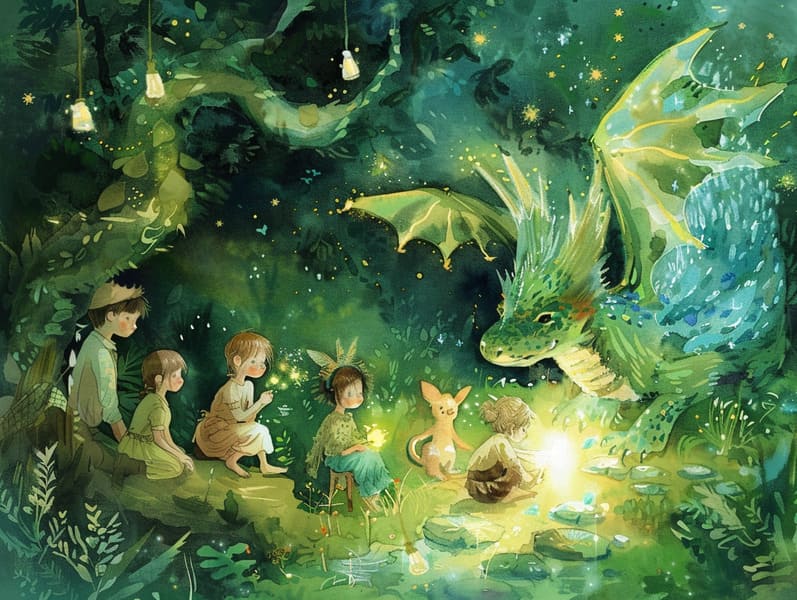
Classic fairy tales have long histories. These stories have been passed down from one generation to the next ages before they were ever recorded. They emerged from a variety of backgrounds, including Middle Eastern traditions. They were initially conveyed among grown-ups, often carrying themes and messages concerning the societal norms and beliefs of the time.
The Grimm brothers, Jacob and Wilhelm (the Grimm brothers), were among the first to gather many of these beloved stories. Their compilation, "Grimm's Folk Tales," included tales like "The Little Glass Slipper," "Hansel and Grethel," and "The True Story of Snow White," which have since become staples in the world of beloved fairy tales. Similarly, the Danish author's whimsical tales, such as "The Mermaid's Tale," and "The Duckling's Story," have stolen hearts worldwide, guaranteeing their place in the pantheon of classic fairy tales.
Though they are centuries old, these stories remain as important as ever, especially as nighttime stories for kids. These magical stories are now available in diverse formats, including colorful picture books, captivating animations, and free fairy tales online.
Their lasting appeal can be traced to several charming aspects:
Key Lessons: Old fairy tales often provide important moral lessons. Narratives like "The Tale of the Boy Who Cried Wolf" teach the value of integrity, while "The Story of the Tortoise and the Hare" stress the merits of determination and unpretentiousness. These tales offer children clear distinctions between correct and incorrect, building their moral compass in a kind yet impactful way.
Warmth and Understanding: Old fairy tales frequently feature characters facing difficulties and adversities, motivating young listeners to connect with their struggles and support their triumphs. For instance, "Beauty and the Beast" reveals the benefit of seeing beyond looks to appreciate the real character of a soul, developing tenderness and comprehension.
Cultural Comprehension: Many old fairy tales are rooted in the cultural contexts from which they came. Delving into these narratives can provide enlightening views into different heritages, nurturing a sense of world awareness and discernment.
Creativity and Fantasy: The mythical elements in ancient fairy tales—mythical creatures—generate children’s dreams. These fairy tales carry readers to fantastical realms, stimulating creative thinking and a sense of curiosity that continues a lifetime.
Old fairy tales are not only captivating but also instructive. They provide spellbinding tools in enhancing various intellectual and emotional capacities in the young. When old fairy tales are recited, they foster verbal development by presenting new language items and complicated sentence structures. This practice also nurtures auditory perception and attention, as young ones concentrate deeply, keen to see what happens next.
Furthermore, talking about the themes and characters of traditional fairy tales can nurture thinking skills and problem-solving abilities. Little ones are educated to detect patterns, expect results, and realize cause and effect. These examinations also aid little ones express their thoughts and feelings, advancing their emotional intelligence.
In today’s cyber age, the prevalence of web-based fairy tales has made these fairy tales more attainable than ever. Internet resources and online apps supply large libraries of Grimm's fairy tales that can be seen or listened on anytime, anywhere. Fairy tales read aloud are particularly prevalent, presenting an interactive method for young readers to experience this site these charming tales. Sound books and read-out-loud videos move characters and settings to life, often joined by delightful audio effects and tunes that improve the tale journey.
The lasting appeal of classic fairy tales lies in their ability to change to present eras while maintaining their essential themes. Contemporary revisions of these narratives often include more varied characters and modern settings, making them pertinent to today’s audience. However, the main ideas of gallantry, understanding, and rightness remain unchanged, continuing to strike a chord with audiences of all ages.
Classic fairy tales also offer a sense of solace and understanding. They afford a well-structured narrative with a straightforward beginning, middle, and end, often closing with the ending of conflicts and the triumph of virtue over corruption. This constancy can be easing for children, offering a sense of constancy in an unstable world.
Traditional fairy tales continue to delight and train new generations, maintaining their captivation and relevance in modern society. As kids' bedtime tales, they extend a perfect blend of allure and teaching, supporting moral values, empathy, and creativity. The accessibility of web-based fairy tales and the likability of fairy tales read aloud ensure that these ancient narratives remain acquirable to new generations.
By protecting and divulging these narratives, we continue to commemorate the rich tapestry of human imagination and cultural heritage. Whether you are experiencing a gorgeously illustrated book, viewing a digital collection, or listening to an voice book, the charm of Grimm's fairy tales is always within reach. These tales reveal of the persistent presence of storytelling and its ability to hold us together across epochs and places.
Whether you are delving into a richly illustrated book, accessing a internet collection, or listening to an spoken story, the grace of timeless fairy tales is always within reach.
These tales reveal of the unchanging force of tales and its ability to unite us across epochs and places, forging a link that enchants and educates alike.